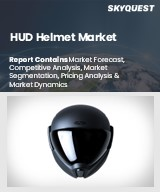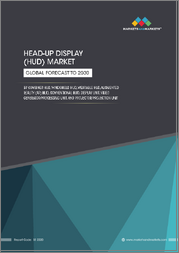
|
시장보고서
상품코드
1642647
헤드업 디스플레이(HUD) 시장 보고서 : 제품 유형별, 기존 및 증강현실별, 기술별, 용도별, 지역별(2025-2033년)Head-Up Display Market Report by Product Type, Conventional and Augmented Reality, Technology, Application, and Region 2025-2033 |
||||||
세계의 헤드업 디스플레이 시장 규모는 2024년 16억 달러에 달했습니다. IMARC Group은 향후 시장이 2033년까지 68억 달러에 이를 전망이며, 2025년부터 2033년까지 17.61%의 성장률(CAGR)을 나타낼 것으로 예측했습니다. 집중력 향상 등 HUD 기술의 장점에 관한 사회적 인지의 고조, 연비 효율이 높은 운전 방법의 중시의 고조, 노인 운전자 증가 등이 시장 성장을 가속하는 주요 요인입니다.
헤드업 디스플레이(HUD)는 사용자의 시야에 주요 정보를 표시하는 디지털 인터페이스입니다. 속도, 네비게이션, 경고 등의 중요한 데이터를 전면 유리 및 차량의 투명 화면에 직접 표시합니다. 운전자의 자연스러운 시야에 중요한 정보를 배치하여 주의 산만을 최소화하고 상황 인식을 높이는 것을 목표로 합니다. 투명한 표면에 투영된 중요한 정보의 오버레이 역할을 하므로 사용자는 본래 작업에서 주의를 끌지 않고도 중요한 데이터에 액세스할 수 있습니다.
집중력 향상과 신속한 의사결정 등 HUD 기술의 장점에 대한 사회적 인지 증가가 세계 시장의 성장을 강화하고 있습니다. 게다가, 연비가 좋은 운전이 중시되면서, 연료 소비 데이터를 실시간으로 표시하는 HUD 수요가 높아지고 있습니다. 게다가 기존의 디스플레이를 읽기 어렵다고 느끼는 노인 드라이버 증가는 헤드업 디스플레이의 사용을 촉진하기 위해 더 보기 쉽습니다. 이와는 별도로 HUD와 같은 안전 기능을 탑재한 자동차에 장려금을 내는 보험회사가 늘고 있는 것도 시장 성장을 뒷받침하고 있습니다. 또한 HUD의 기능에 대한 광범위한 리뷰와 정보를 제공하는 온라인 플랫폼을 통해 소비자의 지식이 높아지고 있다는 것도 시장 성장을 뒷받침하고 있습니다.
헤드업 디스플레이 시장 경향 및 촉진요인 :
안전성에 대한 관심 증가
HUD 기술 수요를 촉진하는 주요 요인 중 하나는 교통 안전에 대한 관심 증가입니다. 기존 대시보드에서는 운전자가 도로에서 눈을 뗄 필요가 있어 주의력 저하나 반응 속도 저하로 이어집니다. HUD는 운전자의 시야에 직접 필요한 정보를 표시하므로 집중력을 잃지 않고 속도, 내비게이션, 경고 신호 등 중요한 데이터에 쉽게 액세스할 수 있습니다. HUD는 보다 안전한 운전 환경에 기여하고 주의 산만을 최소화함으로써 자동차의 안전 기능을 강화하려는 사람들과 자동차 제조업체에게 점점 매력적인 기능이 되고 있습니다.
소비자의 기대 증가
최근 소비자들은 하이테크에 익숙해져 자동차를 포함한 일상 생활에 원활한 기술의 통합을 기대하고 있습니다. 스마트폰과의 연계, 실시간 데이터, 인터랙티브한 요소 등의 기능은 더 이상 사치품이 아니라 필수품으로 생각되고 있습니다. HUD는 편의성, 현대성, 인터랙티브 경험의 조합을 제공함으로써 이러한 기대에 부응하여 현대 자동차에 기대되는 것의 새로운 기준을 세웁니다. 이러한 현대 소비자의 기대와의 일치는 시장에서 헤드업 디스플레이 수요를 뒷받침하고 있습니다.
증가하는 규제의 뒷받침
자동차 안전에 초점을 맞춘 정부의 규제와 노력도 헤드업 디스플레이 수요 증가에 기여하고 있습니다. 일부 국가에서는 HUD를 포함할 수 있는 특정 고급 운전 지원 시스템(ADAS)을 신차에 의무화하는 것을 고려하고 있습니다. 이러한 규제 프레임워크은 교통사고의 건수를 줄이고 전체적인 교통안전을 향상시키는 것을 목적으로 하고 있습니다. 이러한 의무화의 가능성은 자동차 제조업체가 HUD 기술을 보다 넓게 채용하는 원동력이 되고 있습니다.
목차
제1장 서문
제2장 조사 범위 및 조사 방법
- 조사의 목적
- 이해관계자
- 데이터 소스
- 1차 정보
- 2차 정보
- 시장 추정
- 상향식 접근
- 하향식 접근
- 예측 조사 방법
제3장 주요 요약
제4장 서문
- 개요
- 주요 업계 동향
제5장 세계의 헤드업 디스플레이 시장
- 시장 개요
- 시장 실적
- COVID-19의 영향
- 시장 예측
제6장 시장 내역 : 제품 유형별
- 앞 유리 HUD
- 시장 동향
- 시장 예측
- 콤바이너 글라스 HUD
- 시장 동향
- 시장 예측
- 충돌 경고만의 HUD
- 시장 동향
- 시장 예측
제7장 시장 내역 : 기존 및 증강현실별
- 기존 HUD
- 시장 동향
- 시장 예측
- 증강현실 기반의 HUD
- 시장 동향
- 시장 예측
제8장 시장 내역 : 기술별
- CRT 기반 HUD
- 시장 동향
- 시장 예측
- 디지털 HUD
- 시장 동향
- 주요 유형
- 광도파로 HUD
- 시장 동향
- 시장 예측
- 디지털 마이크로 미러 디바이스(DMD) HUD
- 시장 동향
- 시장 예측
- LED HUD
- 시장 동향
- 시장 예측
- 기타
- 시장 동향
- 시장 예측
- 광도파로 HUD
- 시장 예측
제9장 시장 내역 : 용도별
- 항공
- 시장 동향
- 시장 예측
- 자동차
- 시장 동향
- 시장 예측
제10장 시장 내역 : 지역별
- 아시아태평양
- 중국
- 일본
- 인도
- 한국
- 기타
- 북미
- 미국
- 캐나다
- 유럽
- 독일
- 프랑스
- 영국
- 이탈리아
- 스페인
- 기타
- 라틴아메리카
- 브라질
- 멕시코
- 기타
- 중동 및 아프리카
- 터키
- 사우디아라비아
- 이란
- 아랍에미리트(UAE)
- 기타
제11장 SWOT 분석
- 개요
- 강점
- 약점
- 기회
- 위협
제12장 밸류체인 분석
제13장 Porter's Five Forces 분석
- 개요
- 구매자의 협상력
- 공급기업의 협상력
- 경쟁도
- 신규 참가업체의 위협
- 대체품의 위협
제14장 가격 분석
제15장 경쟁 구도
- 시장 구조
- 주요 기업
- 주요 기업 프로파일
- BAE Systems Plc
- Continental AG
- Elbit Systems Ltd.
- E-Lead Electronic Co. Ltd.
- Hudway LLC
- Nippon Seiki Co. Ltd.
- Panasonic Automotive Systems Europe GmbH
- Thales Group
- Valeo
- Yazaki Corporation
The global head-up display market size reached USD 1.6 Billion in 2024. Looking forward, IMARC Group expects the market to reach USD 6.8 Billion by 2033, exhibiting a growth rate (CAGR) of 17.61% during 2025-2033. The increasing public awareness about the benefits of HUD technology like better focus, rising emphasis on fuel efficient driving practices, and the growing number of older drivers are some of the major factors propelling the market growth.
A head-up display (HUD) is a digital interface that presents key information in the line of sight of the user. It provides essential data, such as speed, navigation, and warnings, directly onto a windshield or a transparent screen of the vehicle. It aims to minimize distraction and enhance situational awareness by placing vital information within the natural field of view of the driver. It serves as an overlay of crucial information projected onto a transparent surface, which allows users to access important data without diverting their attention away from their primary task.
The increasing public awareness about the benefits of HUD technology, such as better focus and quick decision-making, is strengthening the growth of the market around the world. Moreover, the rising emphasis on fuel efficient driving practices is catalyzing the demand for HUDs that display real-time fuel consumption data. In addition, the growing number of older drivers, who may find traditional displays harder to read, is catalyzing the use of head-up displays for better legibility. Apart from this, the increasing number of insurance companies that are offering incentives for cars equipped with safety features like HUDs is favoring the growth of the market. Furthermore, the rising consumer knowledge via online platforms that offer extensive reviews and information about HUD features is propelling the growth of the market.
Head-Up Display Market Trends/Drivers:
Increase in safety concerns
One of the primary factors driving the demand for HUD technology is an increasing concern for road safety. Traditional dashboards require drivers to take their eyes off the road, which leads to lapses in attention and slower reaction times. HUDs present essential information directly in the line of sight of the driver, which makes it easier to access critical data like speed, navigation, and warning signals without diverting focus. HUDs contribute to safer driving conditions, a feature that is becoming increasingly appealing to people and automotive manufacturers looking to enhance the safety features of their vehicles by minimizing distractions.
Rise in consumer expectations
Individuals are nowadays more tech-savvy and expect a seamless integration of technology into their daily lives, including their vehicles. Features like smartphone integration, real-time data, and interactive elements are no longer considered luxuries but necessities. HUDs fulfill these expectations by offering a combination of convenience, modernity, and interactive experience, setting a new standard for what is expected in a modern vehicle. This alignment with contemporary consumer expectations helps drive the demand for head-up displays in the market.
Growing regulatory push
Government regulations and initiatives focused on vehicle safety are also contributing to the rising demand for head-up displays. Some countries are exploring the idea of making certain advanced driver-assistance systems (ADAS), which could include HUDs, mandatory in new vehicles. These regulatory frameworks aim to reduce the number of road accidents and improve overall road safety. The potential for such mandates drives automotive manufacturers to adopt HUD technology more widely.
Global Head-Up Display Industry Segmentation:
Breakup by Product Type:
Windshield HUD
Combiner Glass HUD
Collision Warning Only HUD
Windshield HUD dominate the market
A combiner glass HUD uses a separate transparent screen or combiner that is positioned between the driver and the windshield. The information is projected onto this combiner glass rather than the windshield itself. This setup is generally more affordable and easier to install compared to Windshield HUDs. It also offers flexibility, as the combiner glass can be adjusted or removed as needed. These are commonly found in aftermarket HUD solutions and can be added to vehicles that did not come with a built-in HUD.
Breakup by Conventional and Augmented Reality:
Conventional HUD
Augmented Reality Based HUD
Conventional HUD holds the largest share in the market
Augmented reality (AR) based HUDs are a more advanced form of head-up display technology. AR-based systems superimpose computer-generated information over the real-world environment. This means the information displayed can interact with the actual surroundings, providing a more contextual and dynamic user experience. This type of HUD generally requires more advanced hardware and software, including sensors, cameras, and computational units, which makes it more expensive than its conventional counterpart.
Breakup by Technology:
CRT Based HUD
Digital HUD
Optical Waveguide HUD
Digital Micromirror Device (DMD) HUD
Light Emitting Diode (LED) HUD
Others
Digital HUD dominate the market
Cathode ray tube (CRT) based HUDs are one of the earliest forms of head-up displays, originating from the aviation industry. They utilize a CRT to project images onto a combining glass or the windshield. This technology is characterized by its relatively high brightness, making it suitable for various lighting conditions.
Breakup by Application:
Aviation
Automotive
Automotive holds the largest share in the market
In aviation, HUDs have been an essential component for several decades, primarily used in military aircraft and increasingly in commercial planes. These displays project critical flight information such as altitude, airspeed, and the horizon line directly into the pilot's line of sight. This setup allows pilots to access vital data without having to look down at the instrument panel, thus improving situational awareness and flight safety. In modern aviation, more advanced HUDs can even provide real-time updates about air traffic, weather conditions, and potential obstacles, which makes them indispensable tools for pilots.
Breakup by Region:
Asia Pacific
China
Japan
India
South Korea
Others
North America
United States
Canada
Europe
Germany
France
United Kingdom
Italy
Spain
Others
Latin America
Brazil
Mexico
Others
Middle East and Africa
Turkey
Saudi Arabia
Iran
United Arab Emirates
Others
North America exhibits a clear dominance, accounting for the largest head-up display market share
The market research report has also provided a comprehensive analysis of all the major regional markets, which include Asia Pacific (China, Japan, India, South Korea, and others), North America (the United States and Canada), Europe (Germany, France, the United Kingdom, Italy, Spain, and others), Latin America (Brazil, Mexico and others), and the Middle East and Africa (Turkey, Saudi Arabia, Iran, the United Arab Emirates and others). According to the report, North America accounted for the largest market share.
The increasing production of luxury vehicles represents one of the primary factors driving the demand for HUDs in the North American region. Moreover, the rising awareness about the importance of incorporating safety features in an vehicle is favoring the growth of the market in the region. Besides this, the growing use of HUDs in commercial fleets for real-time monitoring of vehicle metrics, route information, and other vital data is influencing the market positively.
North America is estimated to witness stable growth, owing to increasing investments in research and development (R&D) activities, government initiatives, integration of advanced technologies, etc.
Competitive Landscape:
The leading companies are incorporating voice and gesture recognition capabilities, which enable users to interact with the display without having to use manual controls and enhance safety and convenience by reducing distractions. They are also integrating data analytics and connectivity that enable modern HUDs to provide real time updates, such as traffic conditions, weather forecasts, and obstacle detection. Moreover, key players are developing HUDs that can automatically adjust brightness and color based on external conditions, which provides optimum visibility during night, day, or in varying weather conditions and contributes to a safer and more comfortable user experience. They are also equipped with advanced safety features, such as collision warnings, lane departure alerts, and pedestrian detection in HUDs.
The report has provided a comprehensive analysis of the competitive landscape in the market. Detailed profiles of all major companies have also been provided. Some of the key players in the market include:
BAE Systems Plc
Continental AG
Elbit Systems Ltd.
E-Lead Electronic Co. Ltd.
Hudway LLC
Nippon Seiki Co. Ltd.
Panasonic Automotive Systems Europe GmbH
Thales Group
Valeo
Yazaki Corporation
Key Questions Answered in This Report:
- How has the global head-up display market performed so far, and how will it perform in the coming years?
- What are the drivers, restraints, and opportunities in the global head-up display market?
- What is the impact of each driver, restraint, and opportunity on the global head-up display market?
- What are the key regional markets?
- Which countries represent the most attractive head-up display market?
- What is the breakup of the market based on the product type?
- Which is the most attractive product type in the head-up display market?
- What is the breakup of the market based on the conventional and augmented reality?
- Which is the most attractive conventional and augmented reality in the head-up display market?
- What is the breakup of the market based on the technology?
- Which is the most attractive technology in the head-up display market?
- What is the breakup of the market based on the application?
- Which is the most attractive application in the head-up display market?
- What is the competitive structure of the global head-up display market?
- Who are the key players/companies in the global head-up display market?
Table of Contents
1 Preface
2 Scope and Methodology
- 2.1 Objectives of the Study
- 2.2 Stakeholders
- 2.3 Data Sources
- 2.3.1 Primary Sources
- 2.3.2 Secondary Sources
- 2.4 Market Estimation
- 2.4.1 Bottom-Up Approach
- 2.4.2 Top-Down Approach
- 2.5 Forecasting Methodology
3 Executive Summary
4 Introduction
- 4.1 Overview
- 4.2 Key Industry Trends
5 Global Head-Up Display Market
- 5.1 Market Overview
- 5.2 Market Performance
- 5.3 Impact of COVID-19
- 5.4 Market Forecast
6 Market Breakup by Product Type
- 6.1 Windshield HUD
- 6.1.1 Market Trends
- 6.1.2 Market Forecast
- 6.2 Combiner Glass HUD
- 6.2.1 Market Trends
- 6.2.2 Market Forecast
- 6.3 Collison Warning Only HUD
- 6.3.1 Market Trends
- 6.3.2 Market Forecast
7 Market Breakup by Conventional and Augmented Reality
- 7.1 Conventional HUD
- 7.1.1 Market Trends
- 7.1.2 Market Forecast
- 7.2 Augmented Reality Based HUD
- 7.2.1 Market Trends
- 7.2.2 Market Forecast
8 Market Breakup by Technology
- 8.1 CRT Based HUD
- 8.1.1 Market Trends
- 8.1.2 Market Forecast
- 8.2 Digital HUD
- 8.2.1 Market Trends
- 8.2.2 Major Types
- 8.2.2.1 Optical Waveguide HUD
- 8.2.2.1.1 Market Trends
- 8.2.2.1.2 Market Forecast
- 8.2.2.2 Digital Micromirror Device (DMD) HUD
- 8.2.2.2.1 Market Trends
- 8.2.2.2.2 Market Forecast
- 8.2.2.3 Light Emitting Diode (LED) HUD
- 8.2.2.3.1 Market Trends
- 8.2.2.3.2 Market Forecast
- 8.2.2.4 Others
- 8.2.2.4.1 Market Trends
- 8.2.2.4.2 Market Forecast
- 8.2.2.1 Optical Waveguide HUD
- 8.2.3 Market Forecast
9 Market Breakup by Application
- 9.1 Aviation
- 9.1.1 Market Trends
- 9.1.2 Market Forecast
- 9.2 Automotive
- 9.2.1 Market Trends
- 9.2.2 Market Forecast
10 Market Breakup by Region
- 10.1 Asia Pacific
- 10.1.1 China
- 10.1.1.1 Market Trends
- 10.1.1.2 Market Forecast
- 10.1.2 Japan
- 10.1.2.1 Market Trends
- 10.1.2.2 Market Forecast
- 10.1.3 India
- 10.1.3.1 Market Trends
- 10.1.3.2 Market Forecast
- 10.1.4 South Korea
- 10.1.4.1 Market Trends
- 10.1.4.2 Market Forecast
- 10.1.5 Others
- 10.1.5.1 Market Trends
- 10.1.5.2 Market Forecast
- 10.1.1 China
- 10.2 North America
- 10.2.1 United States
- 10.2.1.1 Market Trends
- 10.2.1.2 Market Forecast
- 10.2.2 Canada
- 10.2.2.1 Market Trends
- 10.2.2.2 Market Forecast
- 10.2.1 United States
- 10.3 Europe
- 10.3.1 Germany
- 10.3.1.1 Market Trends
- 10.3.1.2 Market Forecast
- 10.3.2 France
- 10.3.2.1 Market Trends
- 10.3.2.2 Market Forecast
- 10.3.3 United Kingdom
- 10.3.3.1 Market Trends
- 10.3.3.2 Market Forecast
- 10.3.4 Italy
- 10.3.4.1 Market Trends
- 10.3.4.2 Market Forecast
- 10.3.5 Spain
- 10.3.5.1 Market Trends
- 10.3.5.2 Market Forecast
- 10.3.6 Others
- 10.3.6.1 Market Trends
- 10.3.6.2 Market Forecast
- 10.3.1 Germany
- 10.4 Latin America
- 10.4.1 Brazil
- 10.4.1.1 Market Trends
- 10.4.1.2 Market Forecast
- 10.4.2 Mexico
- 10.4.2.1 Market Trends
- 10.4.2.2 Market Forecast
- 10.4.3 Others
- 10.4.3.1 Market Trends
- 10.4.3.2 Market Forecast
- 10.4.1 Brazil
- 10.5 Middle East and Africa
- 10.5.1 Turkey
- 10.5.1.1 Market Trends
- 10.5.1.2 Market Forecast
- 10.5.2 Saudi Arabia
- 10.5.2.1 Market Trends
- 10.5.2.2 Market Forecast
- 10.5.3 Iran
- 10.5.3.1 Market Trends
- 10.5.3.2 Market Forecast
- 10.5.4 United Arab Emirates
- 10.5.4.1 Market Trends
- 10.5.4.2 Market Forecast
- 10.5.5 Others
- 10.5.5.1 Market Trends
- 10.5.5.2 Market Forecast
- 10.5.1 Turkey
11 SWOT Analysis
- 11.1 Overview
- 11.2 Strengths
- 11.3 Weaknesses
- 11.4 Opportunities
- 11.5 Threats
12 Value Chain Analysis
13 Porters Five Forces Analysis
- 13.1 Overview
- 13.2 Bargaining Power of Buyers
- 13.3 Bargaining Power of Suppliers
- 13.4 Degree of Competition
- 13.5 Threat of New Entrants
- 13.6 Threat of Substitutes
14 Price Analysis
15 Competitive Landscape
- 15.1 Market Structure
- 15.2 Key Players
- 15.3 Profiles of Key Players
- 15.3.1 BAE Systems Plc
- 15.3.2 Continental AG
- 15.3.3 Elbit Systems Ltd.
- 15.3.4 E-Lead Electronic Co. Ltd.
- 15.3.5 Hudway LLC
- 15.3.6 Nippon Seiki Co. Ltd.
- 15.3.7 Panasonic Automotive Systems Europe GmbH
- 15.3.8 Thales Group
- 15.3.9 Valeo
- 15.3.10 Yazaki Corporation



















